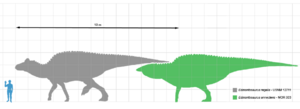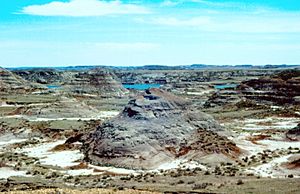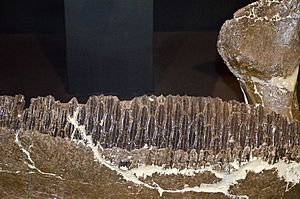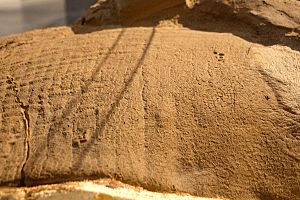Anatotitan facts for kids
Anatotitan is a name that used to be given to a type of dinosaur. Today, scientists believe that Anatotitan was actually the same dinosaur as Edmontosaurus. Edmontosaurus was a very large plant-eating dinosaur. It lived during the Late Cretaceous period, about 68 to 66 million years ago. This was just before the dinosaurs went extinct.
Contents
Edmontosaurus: The Giant Duck-Billed Dinosaur
Edmontosaurus was a type of hadrosaurid. These dinosaurs are often called "duck-billed dinosaurs." This is because their snouts were wide and flat, a bit like a duck's bill. Edmontosaurus was one of the largest duck-billed dinosaurs. It could grow up to 13 meters (43 feet) long. That's about the length of a school bus! It could also weigh as much as 4 metric tons. That's like two cars!
Where Did Edmontosaurus Live?
Edmontosaurus lived in what is now North America. Fossils of this dinosaur have been found in many places. These include Canada and the United States. It lived in areas that are now Alberta and Saskatchewan in Canada. In the U.S., its fossils are found in Montana, South Dakota, North Dakota, Wyoming, and Colorado.
What Did Edmontosaurus Eat?
As a plant-eating dinosaur, Edmontosaurus ate a lot of plants. It had hundreds of small, flat teeth packed together in its jaws. These teeth formed a grinding surface. This was perfect for chewing tough plants. Scientists think it ate things like conifers, cycads, and other plants that grew during its time. Its wide, duck-like bill helped it to scoop up large amounts of vegetation.
Cool Discoveries About Edmontosaurus
Scientists have found many amazing Edmontosaurus fossils. Some of these fossils even include skin impressions. These show that Edmontosaurus had tough, scaly skin. One famous fossil, nicknamed "Dakota," even preserved soft tissues. This included muscles and tendons. These rare finds help us learn how these dinosaurs looked and moved.
Some Edmontosaurus skeletons show signs of injuries. For example, one skeleton has damage to its tail bones. This damage looks like it was caused by a bite from a large predator. Scientists think this bite might have come from a Tyrannosaurus. This shows that even large dinosaurs like Edmontosaurus had to watch out for dangerous hunters.
Edmontosaurus was an important part of its ecosystem. It was one of the last non-avian dinosaurs. It lived right up until the big extinction event. This event wiped out most dinosaurs about 66 million years ago.
Images for kids
-
Skeletons (AMNH 5730, left, and AMNH 5886, right), first mounted in the American Museum of Natural History in 1908.
-
Outdated 1909 life restoration of Trachodon by Charles R. Knight, based on the two specimens (now classified as E. annectens) mounted in 1908 at the AMNH, New York.
-
Skeletal restoration of the E. annectens (then Claosaurus) holotype, by Othniel Charles Marsh.
-
E. annectens paratype YPM 2182 at the Yale University Museum, the first nearly complete dinosaur skeleton mounted in the United States.
-
E. annectens holotype, Smithsonian National Museum of Natural History
-
Mounted skeletons of a juvenile and adult E. annectens at the Houston Museum of Natural Science, nicknamed Diana and Leon
-
The damage to the tail vertebrae of this E. annectens skeleton (on display at the Denver Museum of Nature and Science) indicates that it may have been bitten by a Tyrannosaurus.
See also
 In Spanish: Anatosaurus para niños
In Spanish: Anatosaurus para niños


















